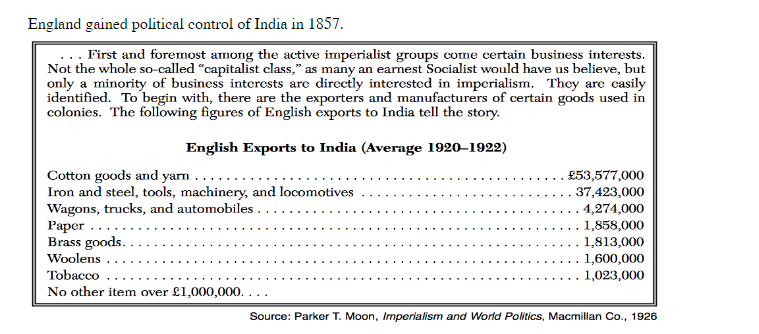England gained political control of India in 1857. First and foremost among the active imperialist groups come certain business interests. Not the whole so-called "capitalist class," as many an earnest Socialist would have us believe, but only a minority of business interests are directly interested in imperialism. They are easily identified. To begin with, there are the exporters and manufacturers of certain goods used in colonies. The following figures of English exports to India tell the story. English Exports to India (Average 1920–1922) Cotton goods and yarn . Iron and steel, tools, machinery, and locomotives Wagons, trucks, and automobiles £53,577,000 37,423,000 . 4,274,000 1,858,000 Рарer Brass goods. 1,813,000 . 1,600,000 1,023,000 Woolens Tobacco No other item over £1,000,000. ... Source: Parker T. Moon, Imperialism and World Politics, Macmillan Co., 1926
England gained political control of India in 1857. First and foremost among the active imperialist groups come certain business interests. Not the whole so-called "capitalist class," as many an earnest Socialist would have us believe, but only a minority of business interests are directly interested in imperialism. They are easily identified. To begin with, there are the exporters and manufacturers of certain goods used in colonies. The following figures of English exports to India tell the story. English Exports to India (Average 1920–1922) Cotton goods and yarn . Iron and steel, tools, machinery, and locomotives Wagons, trucks, and automobiles £53,577,000 37,423,000 . 4,274,000 1,858,000 Рарer Brass goods. 1,813,000 . 1,600,000 1,023,000 Woolens Tobacco No other item over £1,000,000. ... Source: Parker T. Moon, Imperialism and World Politics, Macmillan Co., 1926
Related questions
Question
Summarize the document in your own words (no quotes)

Transcribed Image Text:England gained political control of India in 1857.
First and foremost among the active imperialist groups come certain business interests.
Not the whole so-called "capitalist class," as many an earnest Socialist would have us believe, but
only a minority of business interests are directly interested in imperialism. They are easily
identified. To begin with, there are the exporters and manufacturers of certain goods used in
colonies. The following figures of English exports to India tell the story.
English Exports to India (Average 1920–1922)
Cotton goods and yarn .
Iron and steel, tools, machinery, and locomotives
Wagons, trucks, and automobiles
£53,577,000
37,423,000
. 4,274,000
1,858,000
Рарer
Brass goods.
1,813,000
. 1,600,000
1,023,000
Woolens
Tobacco
No other item over £1,000,000. ...
Source: Parker T. Moon, Imperialism and World Politics, Macmillan Co., 1926
Expert Solution
This question has been solved!
Explore an expertly crafted, step-by-step solution for a thorough understanding of key concepts.
Step by step
Solved in 2 steps
